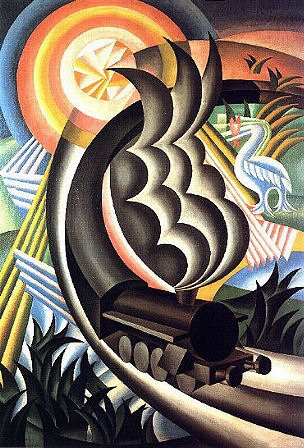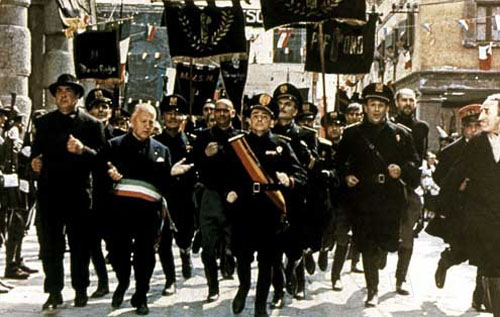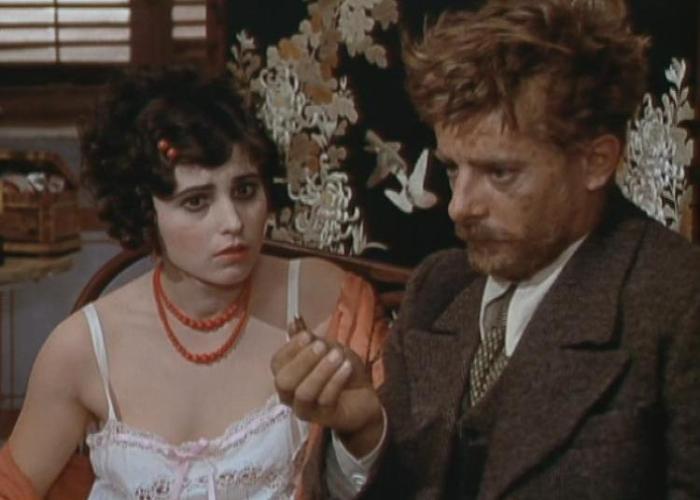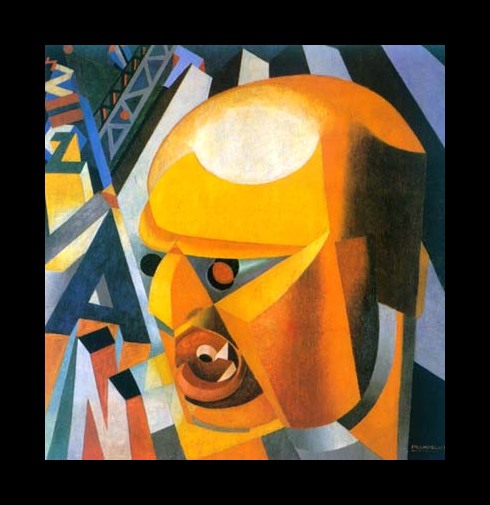There has always been a link, an association, between Italian futurism and different strains of fascism. Ironically, futurism’s desire to overthrow the old and was followed in a parallel manner by the Dadaists and Marcel Duchamp to overturn existing aesthetic conventions in art. Evidently, there is a psychology of the Italian bourgeois and petit bourgeois intellectuals in the period before and during the First World War that gave rise to this singular phenomenon, a conjunction between art and politics, in part on a social class basis, and in part on an independent dynamic, a sort of reactionary gene.

"The mots in liberta poetry of Italian Futurism contained no adjectives, adverbs, finite verbs, punctuation -- anything that would slow it down. It was mostly a collage of nouns, and this form of their poetry was intended to be an uninterrupted sequence of new images. Their parole in liberta poetry functioned on a level below mots in liberta, at what the Futurists believed to be the basis of all language: onomatopoeia. This they defined in their technical manifestos of consisting of four basic types: realistic, analogical, abstract (the 'sound of a state of mind'), and psychic harmony (the fusion of two or three of the abstract representations). Though strictly speaking, parole in liberta is not sound poetry, this fourth type of onomatopoeia approached the kind of phonetic poetry that the later Dadaist would develop. In keeping with Futurist doctrines of returning to the senses, parole in liberta also explored noise as the primal source of their onomatopoeia-rooted linguistics. This had a big influence on the Italian Futurist painter, Luigi Russolo, who in turn invented an Art of Noise," Read More: http://www.oswaldmosley.com/italian-futurism.htm
Italian futurism held the praise of death and the erotic; death as dynamic and transformative, a culmination of the pessimism and negative utopianism that would assume a variant form in Germany.There was a self-alienating element that hit a degree where it could experience its own destruction as an aesthetic pleasure of the highest standard, as if Mussolini hanging in a public square was a scripted act: an epilogue of a totalitarian reality, which encompassed the tragic fusing of a pleasure industry and technological progress in general. This futurist vision of technological society is assumes the expression of “being” in general.
There is no becoming. Only absolute alienation. Whether this, can be claimed to be the basis for the whole historical reality of advanced technological societies is an open question; as is whether almost everything has become “consumption”, reified, and all in relation to a life charged with layers and dimensions representing nothing but what Adorno termed “A fetish of consumption”. Is there a space between the objectified, eroticized “male gaze” at the basis of fascism, and an alternative, what Derrida termed the “bottomless gaze” , a warm shame of indifference into the raw and refreshing encounter? What Steve Reinke termed : If art, and the “truth” of art, exists at the seam between “the nude” and “being naked,”…something genial and disarming.

"The thematic consonances between these films are most deeply felt in their exploration of the conflict between the personal and the political. To begin this analysis Chapter 2 looks at Federico Fellini's Amarcord (1973) and Volker Schl?ndorff's The Tin Drum (1979), two films that adopt a broadly satirical popular style that incorporates elements of humor and the carnivalesque as a means of destabilizing the effect of fascist aesthetics. Both films adopt the theme of "arrested adolescence" as a metaphor for the cultural environment that enabled the widespread appeal of fascism at the macro-level of petit-bourgeois society. " Read More: http://gradworks.umi.com/34/28/3428685.html image: http://www.altfg.com/blog/film-reviews/amarcord-federico-fellini/
Alan Woods: Futurism arose as part of the general artistic ferment that characterised the intellectual life of Europe, and particularly France, in the period before 1914. This was a period of spectacular advance of capitalism, which was developing the productive forces at a dizzying pace. Europe and the USA were industrialising rapidly. Industry was advancing at the expense of agriculture, the proletariat at the expense of the peasantry. Old ideas were crumbling. In the field of science the basis was being laid for a twin revolution, connected with relativity theory and quantum mechanics. The human mind was gradually penetrating beyond the world of appearance and discovering a deeper reality in the sub-atomic world, where the laws of the ordinary world of sense perception do not apply. The sensation existed that this was a new age, an age of progress in which the machine was king. Out of this idea arose the cult of the modern. Read More: http://www.marxist.com/ArtAndLiterature-old/italian_futurism_and_fascism.html a

Love and Anarchy. Lina Wertmuller. 1973. Patricia Erens:Juxtaposing the power of the historical fact against the frailty of the individual, Wertmuller focuses on the struggle of a youthful Italian revolutionary to accommodate two conflicting forces: the external political realities of a Fascist regime and his intimate feelings towards a beautiful young prostitute. The opening montage sequence presents photographs of a militant Mussolini against the ominous tones of military drums, hysterical crowds, and the strident voice of Il Duce. In this arena Tunin, the peasant anarchist commissioned to shoot Benito Mussolini, and Tripolino, the Roman prostitute, play out the days of their lives....Read More: http://www.ejumpcut.org/archive/onlinessays/JC02folder/lovenanarchy.html image:http://html.usagc.org/step1landing_eng.html?afk=usagceng
Woods:The cult of the machine was central to Futurism. Cubism had already started to represent reality as a series of geometrical forms. Futurism took this one step further, elevating the straight lines and streamlined forms of industry to a new form of art. The first Futurist exhibition was held in Paris in 1911, but it originated in Turin in March 1910 and was associated with the work of F.T. Marinetti. It advocated the renovation of Italian art and declared that art could live only by emancipating itself from the dead hand of the past. It repudiated tradition, academic training, museums, picture galleries and the art of previous ages. All these things were regarded as so many fetters on the development of art.
Marinetti experimented with new literary forms that attempted to express emotions directly to the eye of the reader through the use of different types, suggestive arrangements of spacing and lines and other devices that were later developed by Mayakovsky and the Russian Constructivist artists after 1917. Read More: http://www.marxist.com/ArtAndLiterature-old/italian_futurism_and_fascism.html a

Prampolini. Portrait of Marinetti. "To the contrary, Marinetti embraced the new facts of technology, the machine, speed, and dynamic energy, in a movement called Futurism. The futurist response to the facts of the new age is therefore a quite unique reaction from the anti-liberal literati and artists and one that continues to influence certain aspects of industrial and post-industrial sub cultures. An example of a contemporary cultural movement paralleling Futurists is New Slovenian Art, which like futurism embodies music, graphic arts, architecture, and drama. It is a movement whose influence is felt beyond the borders of Slovenia. The best-known manifestation of this art form is the industrial music group Laibach. Marinetti is also the inventor of free verse in poetry, and Futurist adherents have had a lasting impact on architecture, motion pictures and the theater. The Futurists were the pioneers of street theatre. They inspired both the Constructivist movement in the USSR and the English Vorticists Ezra Pound and Wyndham Lewis." Read More: http://www.counter-currents.com/2010/10/filippo-marinetti/
Kerry Bolton:Marinetti’s artistic ideas crystallized in the Futurist movement that originated from a meeting of artists and musicians in Milan in 1909 to draft a Futurist Manifesto. With Marinetti were Carlo Carra, Umberto Boccioni, Luigi Russolo and Gino Severini. The manifesto was first published in the Parisian paper Le Figaro, and exhorted youth to, “Sing the love of danger, the habit of e
y and boldness.”The Futurists were contemptuous of all tradition, of all that is past:We want to exult aggressive motion . . . we affirm that the magnificence of the world has been enriched by a new beauty: the beauty of speed….

Prampolini.1919. Mussolini Black Shirts. "This infatuation with speed, change and modernity tells us a lot about the mentality of a layer of the radical petty bourgeoisie in Italy during the first decade of the 20th century. The unification of Italy in the 19th century created the conditions for the emergence of Italy as a European power. It opened the prospect of the rapid overcoming of its age-old backwardness and its transformation into a modern capitalist economy. For a generation raised on the idea of Italy’s once and future greatness this was an intoxicating prospect. But there was a problem. The belatedness of Italian capitalism meant that it had come too late onto the stage of history. The world had already been divided up between the older capitalist powers, first Britain and France, and then Germany. The ambitions of weak Italian imperialism were thwarted on all sides by powerful neighbours. Its colonial ambitions were limited to miserable pickings such as Albania, Libya and Ethiopia. This bred a sense of frustration and resentment among the nationalist youth that was fertile ground for the rise of imperialist, militarist and fascist tendencies. Read More: http://www.marxist.com/ArtAndLiterature-old/italian_futurism_and_fascism.html image: http://www.artexpertswebsite.ca/pages/artists/prampolini.php
…The machine was poetically eulogized. The racing car became the icon of the new epoch, “which seems to run as a machine gun.” The Futurist aesthetic was to be joy in violence and war, as “the sole hygiene of the world.” Motion, dynamic energy, action, and heroism were the foundations of “the culture of the Futurist future. The fisticuffs, the sprint and the kick were expressions of culture. The Futurist Manifesto is as much a challenge to the political and social order as it is to the status quo in the arts. Read More: http://www.counter-currents.com/2010/10/filippo-marinetti/

Bolton:When the Fascists assumed power in 1922 Marinetti, like D’Annunzio, was critically supportive of the regime. Marinetti considered: “The coming to power of the Fascists constitutes the realization of the minimum futurist program.” Of Mussolini the statesman, Marinetti wrote: “Prophets and forerunners of the great Italy of today, we Futurists are happy to salute in our not yet 40-year-old Prime Minister of marvelous futurist temperament.” Read More: http://www.toqonline.com/blog/filippo-marinetti/





 COMMENTS
COMMENTS